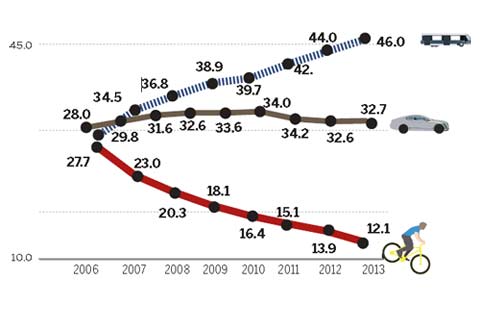Timely steps needed to save the future
Updated: 2014-09-19 07:42
By Christiana Figueres, Mario Molina and Joseph Alcamo(China Daily Europe)
|
|||||||||||
We must act now to avoid climate disaster by the end of this century
The UN Secretary General is hosting the Climate Change Summit on Sept 23, at which heads of state, cities, organizations and companies will announce bold new initiatives to address climate change in the short to medium term.
It is a significant stage on which to voice ambitious, scientifically credible and clear visions on where the world needs to aim over the long haul.
Bold initiatives are certainly needed now to slow the growth in emissions before 2020 - policies need to be put in place that are capable of delivering clean and resilient development.
Yet, like a young person planning a career, a mayor looking at future demographics, or a corporation evolving a business strategy, there also needs to be a long-term view of where we want to be in 50 years.
That long-term vision should be climate neutrality as soon as possible in the second half of the century.
There is ample evidence from the Fifth Assessment Report of the Intergovernmental Panel on Climate Change that global greenhouse gas emissions have to be zero or near zero by the end of the 21st century if we want to achieve the goal of holding a global temperature rise below 2 C.
It is also the best guarantee of ensuring that the poor and vulnerable are spared from ever more threatening conditions such as heat waves, crop failures, floods and water shortages that will increasingly threaten their lives and livelihoods.
Continued unabated, emissions pose an unacceptable risk of pushing our climate system toward potentially irreversible changes with highly damaging impacts to all sectors of society.
Let us be clear. Climate neutrality is not nirvana nor an alternative universe - it is about dramatically reducing current greenhouse gas emissions to the point where we reach a balance between those emissions entering the atmosphere, and the capacity of the Earth to absorb them.
This will require charting the path from the high-emissions society we have today, including initially through some level of certified carbon offsets, to a deep, de-carbonization of the global economy, before arriving finally at a climate neutral family of nations.
It also demands a rapid transformation in the way we value healthy ecosystems to ensure that nature will continue to play an ever more central role in removing carbon from the atmosphere.
This will require significant investment in cleaner, greener energy and energy efficiency in transport and buildings, alongside smarter management to sustain, expand and restore degraded coastal zones, forests and soils.
Overall this will be a much less costly economic development path for the entire planet, preventing potentially enormous costs connected with climate change impacts.
It will also be good for jobs, with many emerging from the construction of green buildings, low energy transportation systems and other climate-friendly infrastructure, as well as from natural-resources management.
The effort is undoubtedly long-term and ambitious, but must be seen as the eventual target so that today's decisions are taken with the long game in mind.
Climate neutrality may seem like a tall order in 2014 with global emissions still climbing despite the growing penetration of renewable energy, improved energy efficiency in many countries and actions to sustainably manage natural assets like forests.
But some countries have already glimpsed the long term and are pointing their economies in that direction, from Bhutan and Costa Rica to Papua New Guinea, Sweden and Switzerland.
Many cities have become affiliated with associations like International Council for Local Environmental Initiatives, an international association of local governments and national and government organizations that have made a commitment to sustainable development, and the C40, a network of the world's megacities taking action to reduce greenhouse gas emission. They are pledging ambitious long-term targets, some of which call for 80, 90 and even 100 percent emission reductions.
These pioneering urban centers range from Copenhagen and Stockholm to Oslo and Seattle.
Visionary companies, many of them household names in the Internet, high tech and banking sectors, are following suit.
The UN Secretary General's summit at the UN headquarters in New York is about raising ambition en route to the Lima, Peru UN Climate Convention meeting later in the year and in advance of the UN Climate Convention meeting in Paris in late 2015.
In Paris, nations have agreed to ink a new agreement that can mark a turning point toward bending down the current greenhouse emissions curve and assisting the poor and vulnerable to better adapt to the climate change already underway.
But as the science spells out, this is not the end game, if poverty is to be truly eradicated and our collective goal of a safe and secure world is to be realized.
Only a long-term vision of climate neutrality in the second half of the century can do that and in doing so provide a real and exciting prospect for over 9 billion people of a functioning, fit and healthy world for generations to come.
Christiana Figueres is executive secretary, UN Framework Convention on Climate Change; Mario Molina is Nobel Prize-winning chemist and president of Molina Center on Energy and Environment; and Joseph Alcamo is executive director, Center for Environmental Systems Research at University of Kassel, and former UN environment program chief scientist. The views do not necessarily reflect those of China Daily.
(China Daily European Weekly 09/19/2014 page11)
Today's Top News
'Yes' in Scotland could be 'maybe' for Chinese firms
Cooperation helps extradite fugitives
Xi, Modi set friendly tone for visit
Collector has 'proof' of atrocities
Naked newborn survives typhoon
How Alibaba IPO learnt from Facebook's mistake
Russia to beef up troops in Crimea
10 problems of Chinese society
Hot Topics
Lunar probe , China growth forecasts, Emission rules get tougher, China seen through 'colored lens', International board,
Editor's Picks

|

|

|

|

|

|





